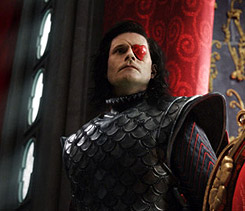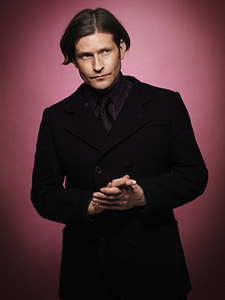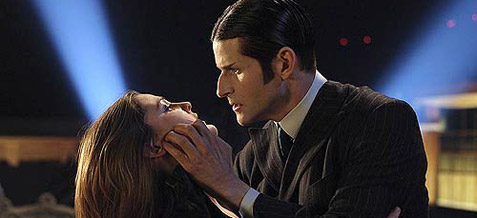
Interview Date: 05/28/2010
Run Date: 05/31/2010
Interviews Home / Movies Home / Bullz-Eye Home
It was only a few months ago that Bullz-Eye was invited to participate in the press junket for “Hot Tub Time Machine,” at which point our man David Medsker chatted with Crispin Glover about his return to the world of mainstream comedy, but when we were presented with the opportunity to chat with Glover about working with Tim Burton on “Alice in Wonderland,” we could hardly refuse. Like David, I learned firsthand that Crispin Glover is a man who is prone to respond to questions with lengthy, well-considered responses. Knowing this in advance, however, allowed me to avoid taking the usual route of picking items from his filmography and asking, “What do you remember about working on this project?” Instead, I opted to ask about how, in the early years of his film career, he came to make such a dramatic shift from high school comedies like “My Tutor” and “Teachers” to darker fare like “River’s Edge. In retrospect, I do kinda wish I’d followed up with a different question, but his bemusement at his inability to answer it very well made actually made for a pretty funny conclusion to our conversation.
Crispin Glover: Hi, Will! How are you doing?
Bullz-Eye: I’m good, Crispin. Good to talk to you!
CG: Good to talk to you, too!
BE: It must be a little strange to still be talking about a film that just crossed the $1 billion box-office mark.
CG: No, it’s great! I’m very happy to be talking about a film that just crossed the $1 billion box-office mark! (Laughs) There’s nothing bad about it!
BE: Now, I know you provided the voice of Six in the animated film, “9,” which Tim Burton produced, but which came first? And did one directly lead to the other?
CG: “9” was previous to “Alice in Wonderland,” but I don’t think they had anything to do with each other. It seems strange, but when I was working on “Alice in Wonderland”…I mean, I knew I had just worked on “9,” and I kind of wondered in my mind about it, but for whatever reason, when working on “Alice in Wonderland,” when I was working with Tim, of course, we really only talked about “Alice in Wonderland”-related things, and…well, it just never came up in conversation! (Laughs) He never once mentioned “9.” But it was a real pleasure working with him. I’d actually known him from years before. I first met Tim Burton right after he’d done “Pee-Wee’s Big Adventure.” We were socially friendly, and I’d always liked him a lot; I knew he was an excellent artist and drew a lot of things. I got along well with him, but I hadn’t talked to him in many years. I was touring with my films in Australia…I make my own films, and when I show them, I do a live performance before them. In fact, I think I might’ve talked to your website about them at some point.
BE: You did, sort of. One of our other editors was part of the “Hot Tub Time Machine” press junket, and I know that there was a certain amount of discussion about them at that time.
CG: Oh, okay! All right, I knew I’d heard of the website. (Laughs) But in any case, I was in Australia, touring with my films and live show, and I got an E-mail from my agent, saying that there was interest in me for Tim Burton’s “Alice in Wonderland.” I thought, “Okay, that sounds good.” I thought it would be for a day or two, maybe a few days or something, and I would’ve been very happy to do that. I was in the middle of touring, and I was supposed to be continuing from Australia into Europe and didn’t think that it would affect my tour at all, but then the offer came in, and it was for virtually the entire run of the film. I didn’t even know what part it was for, so I asked my agent, and he said it was for the Knave of Hearts. So I looked up the Knave of Hearts in the original book online and read through the chapters that had to do with the Knave of Hearts, and…it didn’t really seem like a character that would require the run of the film. I thought, “Something must be different.” And then I got the actual screenplay, and it was extremely different. I could see that it was written as a sequel. But it was a great part, and I was ecstatic to be in it…and I’m still ecstatic to be in it! (Laughs) It was a great thing, and I’m very, very grateful and pleased to be in this film.
BE: So what was the extent of your Lewis Carroll knowledge before taking the part?
 CG: Well, you know, it’s a funny thing about Lewis Carroll and his works. You feel very familiar with it, being in this culture, because his stuff is everywhere. So even if you haven’t read his things, you feel like on some level you have. I’d read bits and pieces of stuff that he’d written, but I’d never read the entire books. In fact, I finally just read “Alice’s Adventures in Wonderland.” I still have not read “Through the Looking Glass,” but I intend to, because I loved reading “Adventures in Wonderland.” What was interesting to me about it is that there are still things in that original book that I’ve never seen in… (Hesitates) I mean, I haven’t seen that many versions of “Alice in Wonderland,” but there are things in the book that are extremely compelling that I’ve never seen in any of the versions I have seen. I loved reading it, though, and I plan to read “Through the Looking Glass,” and I’m looking forward to it, because I really, really enjoyed the first book, particularly because of that element where you feel like you’re familiar with it, but you’re really not. Not until you’ve actually read it, because it is a completely different thing, no matter how someone interprets it…which, I think, was an interesting thing that they did with this movie. By freely understanding that this is a very evident sequel, it’s completely fair game to be influenced by a great work like “Alice in Wonderland” and then be able to freely do things that will be enjoyable to make it as a filmmaker.
CG: Well, you know, it’s a funny thing about Lewis Carroll and his works. You feel very familiar with it, being in this culture, because his stuff is everywhere. So even if you haven’t read his things, you feel like on some level you have. I’d read bits and pieces of stuff that he’d written, but I’d never read the entire books. In fact, I finally just read “Alice’s Adventures in Wonderland.” I still have not read “Through the Looking Glass,” but I intend to, because I loved reading “Adventures in Wonderland.” What was interesting to me about it is that there are still things in that original book that I’ve never seen in… (Hesitates) I mean, I haven’t seen that many versions of “Alice in Wonderland,” but there are things in the book that are extremely compelling that I’ve never seen in any of the versions I have seen. I loved reading it, though, and I plan to read “Through the Looking Glass,” and I’m looking forward to it, because I really, really enjoyed the first book, particularly because of that element where you feel like you’re familiar with it, but you’re really not. Not until you’ve actually read it, because it is a completely different thing, no matter how someone interprets it…which, I think, was an interesting thing that they did with this movie. By freely understanding that this is a very evident sequel, it’s completely fair game to be influenced by a great work like “Alice in Wonderland” and then be able to freely do things that will be enjoyable to make it as a filmmaker.
BE: Given that Tim Burton’s films tend to offer both visual and psychological stimulation, how was he to work with as a director?
CG: He was great! What was most apparent to me and what I appreciated very much was…I mean, I knew it from having known him a little bit before, but every time someone has an artistic sense of something and has something that they want to accomplish, people are going to challenge whatever that idea is, whether they’re just challenging it for the sake of discussion, or they’re in power and dealing with your monetary element, or they’re doing it for the sake of the commerce of the film or whatever, but it can definitely cause interference in one’s artistic vision. I’m sure Tim Burton has dealt with that…a lot!...in his career… (Laughs) …and you can tell that, being someone that’s a sensitive artist, he doesn’t like that when it happens to him, and he doesn’t want to do that to other people. So it’s a very nice feeling all around: you can tell that he works with people that he likes, he wants them to come forth with their thoughts and ideas, and he wants them to not feel constricted by things. Of course, he has a very strong vision as well, but it’s not like a dictatorial kind of envisioning. In the best sense of the word, it’s collaborative. I mean, you’re still a slave to the script and a slave to the idea, but he doesn’t want to constrict you to, “It has to be this way.” There was something I had a question about kind of early on…it was something about the eye patch, and I was wondering if maybe this eye patch would have a kind of restriction of emotive element. He let me and the makeup artist play with the concept of maybe having a scar that didn’t involve an eye patch, that the eye was visible, but it became apparent while doing it that the Queen’s character is supposed to be so enthralled with my character that there was this kind of…women’s fantasy element about him. Not a pirate, but, y’know, the eye patch, the scar, the sword…there’s something kind of cutting-a-romantic-figure about him that was really apparent in this particular Wonderland universe where it made sense to have that. But by letting me go through with what I did, it helped me to have ownership of that idea, whereas if he’d just said, “No, you’re wearing an eye patch and that’s it,” I would’ve always felt like, “Maybe there’s a problem.” But he understands that it’s very important to be able to figure something out and feel good about it, so he let me do it, and by letting me do that, I was really in with what the original idea was anyhow, and I understand why it was so important.
BE: I wanted to ask you briefly about your early career.
CG: Sure!
BE: Over the course of three years, you jumped from “My Tutor” to “River’s Edge.” Now, that’s a hell of a jump as far as the depth of the films you were doing. Was that a conscious decision on your part to follow quality roles rather than big paydays?
CG: Yeah, “River’s Edge” was definitely a very specific choice of that, maybe even to my… (Hesitates) Well, I was about to say something that I’m now not going to say, but…
(Writer’s note: Not to put words in Glover’s mouth, but what he was almost certainly going to say was something about how he did “River’s Edge” immediately after “Back to the Future,” which kinda sorta led to his subsequent non-appearance in the “Future” sequels. As it happens, though, he tackled this very topic in his conversation with Mr. Medsker, which you can read here.)
CG: Yes, I did “River’s Edge” for scale, and “River’s Edge” was the first film that I acted in after “Back to the Future” came out. I’m very proud of “River’s Edge.” That’s really a good film, and I still am very proud of that film, but, I mean, you know, things have changed very much in the industry as far as what kind of films are being made. The kind of films that I was watching when I was 15, 16, 17, 18, in acting class…I would go to a lot of the revival theaters in Los Angeles, and they were playing a lot of the films made in the 1950s, ‘60s, and ‘70s, which tended toward questioning things a lot. A lot of the films that are being corporately financed and distributed at this point are not doing that. It’s a very specific and evident shift in what kinds of films are being made. My own films that I make and tour with, I do question things in them, but I also understand that, like I say, the focus of the industry has changed, and it would be not a good idea for me to only act in films that question things. Like, “River’s Edge,” I would say, is a film that is in that kind of tradition, but right now it’s very important for me to act in the current climate of filmmaking…because, basically, the money I make helps me to finance my films. (Laughs) I’m much more at ease with that now than I was at a certain time.
When I had to finance my film “It Is Fine, Everything Is Fine,” the main actor in it (Steven C. Stewart) had a severe case of cerebral palsy, which is not degenerative, but he was 62 when we shot this film, he had written it, he’s the main actor in it, and in the year 2000, one of his lungs collapsed. It became apparent that, if we didn’t start shooting soon, we might never get to shoot anything at all. That was right at the time that the first “Charlie’s Angels” film was coming to me, and I realized that with the money I made from that, I could put it straight into making the Steven C. Stewart film…and that’s exactly what happened. I’m going to be playing both of my films – “What Is It?” and “Everything Is Fine” – next week at the IFC Center in New York, and I perform a live show before them. I’m really proud of “Everything Is Fine.” When the whole trilogy of films that I’m making is included, “Everything Is Fine,” which is the second film, will not only probably be viewed as the best film of the trilogy, but I feel like it’ll be the best film I’ll have anything to do with in my entire career. It’s something I’m very passionate about. I was very glad that, with the money I made from the “Charlie’s Angels” film, I was able to put it straight into making “Everything Is Fine,” but on top of that, I enjoyed working on “Charlie’s Angels”! I liked the character, and I realized that if the film was successful financially, it would be very good for my acting career.
 To your question, after “Back to the Future” had come out, was I choosing art over commerce? There was a decade or so…more than a decade, actually…where I was doing that. I was looking for films that would somehow psychologically reflect what my interests were, and “River’s Edge” did do that, but subsequent to that, most of them didn’t…and they also didn’t necessarily make that much money, which was not necessarily that good for my acting career! (Laughs) So it became very apparent to me after “Charlie’s Angels” had come out, and after I’d been able to finance this project that I’d been so passionate about, that this was really the way that I needed to start regulating my career. So I started choosing to act in films that were more commercial, but they actually started to increase in their interest, the films became higher profile, and I’ve been able to continue financing my own projects. So it was the right thing to do. And I’ve enjoyed working on these films! Working on “Alice in Wonderland” has probably been my favorite professional experience in the business. Everybody was very nice, it was a great part, it was great working with Tim Burton, and the whole cast and crew…everything about it. And, of course, the film’s done very well, which subsequently should… (Starts to laugh) … help my acting career, which will help my filmmaking. So there’s nothing bad about it. It’s all very, very positive.
To your question, after “Back to the Future” had come out, was I choosing art over commerce? There was a decade or so…more than a decade, actually…where I was doing that. I was looking for films that would somehow psychologically reflect what my interests were, and “River’s Edge” did do that, but subsequent to that, most of them didn’t…and they also didn’t necessarily make that much money, which was not necessarily that good for my acting career! (Laughs) So it became very apparent to me after “Charlie’s Angels” had come out, and after I’d been able to finance this project that I’d been so passionate about, that this was really the way that I needed to start regulating my career. So I started choosing to act in films that were more commercial, but they actually started to increase in their interest, the films became higher profile, and I’ve been able to continue financing my own projects. So it was the right thing to do. And I’ve enjoyed working on these films! Working on “Alice in Wonderland” has probably been my favorite professional experience in the business. Everybody was very nice, it was a great part, it was great working with Tim Burton, and the whole cast and crew…everything about it. And, of course, the film’s done very well, which subsequently should… (Starts to laugh) … help my acting career, which will help my filmmaking. So there’s nothing bad about it. It’s all very, very positive.
BE: Lastly, I was just curious about something. I know that, during your interviews for “Hot Tub Time Machine,” you mentioned how you’d never worked with John Cusack before but that you’d crossed paths a few times.
CG: That’s right.
BE: Obviously, you weren’t part of the Brat Pack, per se, but in the ‘80s, did you tend to run in the same circles as the other actors of your generation, or did you tend to hang with – for lack of a better term – an artsier crowd?
CG: Well, I certainly know people who would be, I guess, what you’d call charter members of the Brat Pack. (Laughs) I know all kinds of actors, people in the business who aren’t actors, and people who aren’t in the business at all. Sure, if you were in the business at that time, you were definitely bound to work with or know or associate with people that are of a similar age range.
BE: Right, but…I guess what I’m asking is if you tended to run with artsier types more so than fellow actors.
CG: (Long pause) I, uh… (Starts to laugh) The reason it’s a hard question to answer is that “artsy” is kind of a slang word. I mean, somebody might call a Brat Pack member artsy, and somebody might call an art student artsy, so…it’s hard to say. Like I say, I’ve been friends with and known people who are in the industry that would be called part of that group, I suppose, and I’ve been friends with people that have nothing to do with the industry. I don’t know that there’s necessarily a preference one way or the other. I certainly have friends and stuff, but for the most part, I…I mean… (Starts to laugh again) This is actually a hard question to answer! I think that’s the best way I can do it. I don’t know if that was a proper answer. Was that what you were looking for?
BE: (Laughs) That’s fine. Sorry, I didn’t intend to end our conversation on a stumper!
CG: (Laughs) That’s all right! You know, part of it is that, with the term “Brat Pack,” it’s, like, who exactly is a member of this so-called Brat Pack and who isn’t? (Laughs) I’m not even quite sure myself! If you wanted to say that only people that were in “The Breakfast Club” and “St. Elmo’s Fire” are in it…I mean, those are the main films they used to define the Brat Pack?
BE: Generally, yeah.
CG: I mean, I’ve known people who were in those films. In fact, I’ve worked with one of them: Demi Moore was in the second “Charlie’s Angels” film. So there’s a specific time when I worked with someone who would be considered a charter member. But, still, you wouldn’t really think of her as being someone who was in the Brat Pack…especially not if you only think of her from “Charlie’s Angels”! (Laughs) But she was one of the main actors in “St. Elmo’s Fire,” wasn’t she?

BE: She was.
CG: Okay, I thought so. Well, she was very nice. I enjoyed working with her a lot. She was very nice. She was a very nice person. (Hesitates) I still don’t know if I’ve answered your question, though. (Laughs)
BE: You’re fine. (Laughs) Well, thank you, Crispin. It’s been a real pleasure talking to you…
CG: You, too!
BE: …and I just wanted to close by saying that your video for “Clowny Clown Clown” remains one of the most disconcerting things I’ve ever seen…and I think I mean that as a compliment. (Laughs)
CG: (Laughs) Well, good! Yeah, you know, people say that a lot, and, of course, that was something I made a long time ago, but I’m proud of it. It’s a relatively short piece, but if people enjoyed that, I really believe that they’ll like both “What Is It?” and “Everything Is Fine,” my feature films that I tour with…and if it makes sense to put a link into the article somehow to CrispinGlover.com, that would be a very good thing.
BE: Consider it done.
CG: All right! Terrific!
BE: Well, again, Crispin, thanks a lot for taking the time to talk today.
CG: Well, thank you, too! Have a good day!
You can follow us on Twitter and Facebook for content updates. Also, sign up for our email list for weekly updates and check us out on Google+ as well.











